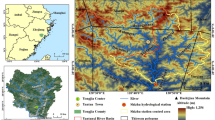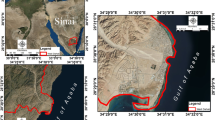Abstract
Laos is a mountainous, rainy and less developed country in Southeast Asia. In Laos, floods represent a major constraint on social economic development, causing a large number of casualties and property losses each year, among which the impact from flash floods is also very prominent. Especially in recent decades, with the development of social economy and the intensification of hydropower development, the serious threat from flash floods is becoming more and more obvious. However, there is no fundamental defence system for flash floods been established yet in this country, and the basic knowledge on local flash flood development is also ignored. For filling this gap, taking the Nam Ou River Basin as an example, this paper tries to find out the most helpful hazard assessment method for current Laos based on comparative analysis from the flash flood potential index, the calculation of curve number–rainfall erosivity and the extrapolation method. The results show that the extrapolation method based on spatial lag model constructed by the data from Yunnan, China, presents the most reliable outcome compared with the other two methods, indicating the spatial autocorrelation model can also be useful for extrapolation, effectively. Besides, the scale effect of different potential impact elements on flash flood, i.e. the spatial correlation between each element and the distribution of flash flood events at different spatial statistic units, was also preliminary studied. It is found that the degree of correlation in spatial analysis depends on the short board effect, i.e. only the element that restricts the regional flash flood developmental system can be the key factor. The correlations of most watershed elements increase or decrease directly with the rise of watershed scale, and the values of coefficients tend to be stable at large watershed scales.







Similar content being viewed by others
References
Alexander DE (1993) Natural disasters. UCL Press Limited, London, pp 1–632
Anselin L (1988) Spatial econometrics: methods and models. Kluwer, Dodrecht
Ashley S, Ashley W (2008) Flood fatalities in the United States. J Appl Meteorol Climatol 47:806–818
Bhaskar NR, French MN, Kyiamah GK (2000) Characterization of flash floods in Eastern Kentucky. J Hydrol Eng 5(3):327–331
Borga M et al (2011) Flash flood forecasting, warning and risk management: the HYDRATE project. Environ Sci Policy 14:834–844
Changjiang Institute of Survey, Planning, Design and Research (2018) Comprehensive planning of the Nam Ou River Basin in Laos, report for the Ministry of Natural Resources and Environmental Protection, Lao PDR
Chinese Flood Control and Drought Relief Headquarters (2013) Bulletin on flood and drought disasters in China in 2013. China Water and Power Press, Beijing
Chow VT, Maidment DR, Mays LW (1988) Applied hydrology. McGraw-Hill, New York
Costache R (2019a) Flash-flood potential assessment in the upper and middle sector of Prahova river catchment (Romania). A comparative approach between four hybrid models. Sci Total Environ 659:1115–1134
Costache R (2019b) Flash-flood Potential Index mapping using weights of evidence, decision Trees models and their novel hybrid integration. Stoch Env Res Risk Assess 33:1375–1402
Costache R, Zaharia L (2017) Flash-flood potential assessment and mapping by integrating the weights-of-evidence and frequency ratio statistical methods in GIS environment–case study: Basca Chiojdului River catchment (Romania). J Earth Syst Sci 126:59. https://doi.org/10.1007/s12040-017-0828-9
Department of Water Resources (2016) Nam Ou River Basin profile, Vientiane, Lao PDR
Du J, Xiao X, Cai DM et al (2015) Hazard assessment of mountain torrent debris flow in Wenchuan seismic area. J Yangtze River Sci Res Inst 32(3):77–83
Du J, Ren HY, Zhang PC et al (2016) Comparative study of the hazard assessment of mountain torrent disasters in macro scale. J Catastrophol 31(03):66–72
Ebrahimian M, See LF, Ismail MH et al (2009) Application of natural resources conservation service–curve number method for runoff estimation with GIS in the Kardeh watershed, Iran. Eur J Sci Res 34:575–590
Esri (1995–2010) Arcgis 10 help, USA
Florax RJ, Rey SJ (1995) The impacts of misspecified spatial interaction in linear regression models. In: Anselin L, Florax RJGM (eds) New directions in spatial econometrics. Springer, Heidelberg
Gan JJ, Sun HY, Huang RQ et al (2012) Study on mechanism of formation and river blocking of Hongchuangou Giant Debris Flow at Yingxiu of Wenchuan County. J Catastrophol 27(1):5–16
Georgakakos KP (1986) On the design of national, real-time warning systems with capability for site-specific, flash flood forecasts. Bull Am Meteor Soc 67(10):1233–1239
Griffith DA (1996) Some guidelines for specifying the geographic weights matrix contained in spatial statistical models. In: Arlinghaus SL (ed) Practical handbook of spatial statistics. CRC Press, Boca Raton
Hadley J (2002) Report for 2002TX58B: real-time distributed runoff estimation using NEXRAD precipitation data. Retrieved 2003. http://twri.tamu.edu/docs/funding/usgs/2002-03/hadley.pdf
Helalia AM (1993) The relation between soil infiltration and effective porosity in different soils. Agric Water Manag 24(8):39–47
Helalia AM, Letey J, Graham RC (1988) Crust formation and clay migration effects on infiltration rate. Soil Sci Soc Am 52:251–255
Lam SN, Quattrochi DA (1992) On the issues of scale, resolution, and fractal analysis in the mapping sciences. Prof Geogr 44(1):88–98
Li J, Chen QD, Kang ZC (1979) A study on the mudflow of the Jiangjia Ravine, Dongchuan District, Yunnan Province. Acta Geogr Sin 34(2):156–167
Lin DJ, Zhen ZC, Zhang XZ et al (2016) Characteristic and influencing factors of soil infiltration of different land use patterns. J Soil Water Conserv 24(1):33–36
Liu CZ, Miao TB, Chen HQ et al (2011) Basic feature and origin of the “8·8” mountain torrent-debris flow disaster happened in Zhouqu County, Gansu, China, Aug. 8, 2010. Geol Bull China 30(1):141–150
Luo ZF, Pu DC, Xie HB et al (2011) Landslide hazard evaluation in debris flow catchment area based on GIS and information method. China Saf Sci J 21(11):144–150
Marchi L et al (2010) Characterisation of selected extreme flash floods in Europe and implications for flood risk management. J Hydrol 394(1–2):118–133
Meng Q, Cieszewski CJ, Madden M et al (2007) K nearest neighbor methods for forest inventory using remote sensing data. GISci Remote Sens 44(2):149–165
National Weather Service. NWS glossary. http://w1.weather.gov/glossary/index.php
Natural Resources Conservation Service (1986) Urban hydrology for small watersheds, TR-55. US Department of Agriculture
Plate EJ (2007) Early warning and flood forecasting for large rivers with the lower Mekong as example. J Hydroenviron Res 1(2):80–94
Saharia M, Kirstetter PE, Vergara H et al (2017) Mapping flash flood severity in the United States. J Hydrometeorol 18(2):397–411
Shan XZ, Wei YQ, Yan HJ et al (1998) Influence of organic matter content on soil hydrodynamic parameters. Acta Pedol Sin 35(1):1–9
Sharpley AN, Williams JR (1990) EPIC-erosion/productivity impact calculator: 1. Model documentation. US Department of Agriculture Technical Bulletin No. 1768, US Government Printing Office, Washington, DC
Shi CX (2008) Scaling effects on sediment yield in the upper Yangtze River. Geogr Res 4:800–810
Smith GE (2010) Development of a flash flood potential index using physiographic data sets within a geographic information system. Dissertations & Theses-Gradworks
Soil Conservation Service (1972) SCS national engineering handbook, section 4 hydrology. Soil Conservation Service, US Department of Agriculture, Washington, DC
Stanimir K, Slavoljub D, Tomislav S et al (2017) Torrential flood prevention in the Kolubara river basin. J Mt Sci 14(11):2230–2245
Su PC, Wei FQ, Xie T et al (2012) Causal analysis of debris flow on August 18, 2010 in Gongshan, Yunnan Province and its harm to the development and utilization of mineral resources. Resour Sci 34(7):1248–1256
Tang C, Tie YB (2009) Reconnaissance and analysis on the rainstorm induced debris flow in Weijiagou Valley of Beichuan City after the Wenchuan Earthquake. Mt Res 27(5):625–630
Tobler W (1970) A computer movie simulating urban growth in the Detroit region. Econ Geogr 46(Supplement):234–240
Wang Z, Lai C, Chen X et al (2015) Flood hazard risk assessment model based on random forest. J Hydrol 527:1130–1141
Water Resource and Environment Administration (2008) National water profile, Vientiane, Lao PDR
Xiong JN, Li J, Chen WM et al (2019) Spatial–temporal distribution and the influencing factors of mountain flood disaster in southwest China. Acta Geogr Sin 74(7):1374–1391
Xu JX, Yan YX (2005) Scale effects on specific sediment yield in the Yellow River basin and geomorphological explanations. J Hydrol 307:219–2321
Youssef AM, Pradham B, Hassan AM (2011) Flash flood risk estimation along the St. Katherine road, southern Sinai, Egypt using GIS based morphometry and satellite imagery. Environ Earth Sci 62(3):611–623
Zaharia L, Costache R, Prăvălie R et al (2015) Assessment and mapping of flood potential in the Slănic catchment in Romania. J Earth Syst Sci 124(6):1311–1324
Zeleňáková M, Gaňová L, Purcz P et al (2015) Methodology of flood risk assessment from flash floods based on hazard and vulnerability of the river basin. Nat Hazards 79(3):2055–2071
Zeng Z, Tang G, Long D et al (2016) A cascading flash flood guidance system: development and application in Yunnan Province, China. Nat Hazards 84(3):2071–2093
Zhang MD, Li M, Dai CR et al (2016) Simulation study of flood in Yunnan based on the flood area model. J Catastrophol 31(1):78–82
Acknowledgements
This research has been sponsored by the National Key R&D Program of China (Grant No. 2018YFC1505201), the program of National Natural Science Foundation of China (Grant No. 41501109, 41902300) and the Opening Fund of State Key Laboratory of Geohazard Prevention and Geoenvironment Protection, Chengdu University of Technology (Grant No. SKLGP2019K001). We are grateful to Silvan Ragettli, a researcher from hydrosolutions ltd, Zurich, Switzerland, for suggestions and guidance of this paper.
Author information
Authors and Affiliations
Corresponding author
Additional information
Publisher's Note
Springer Nature remains neutral with regard to jurisdictional claims in published maps and institutional affiliations.
Rights and permissions
About this article
Cite this article
Du, J., Fan, Zj. & Pu, J. Comparative study on flash flood hazard assessment for Nam Ou River Basin, Lao PDR. Nat Hazards 102, 1393–1417 (2020). https://doi.org/10.1007/s11069-020-03972-3
Received:
Accepted:
Published:
Issue Date:
DOI: https://doi.org/10.1007/s11069-020-03972-3




